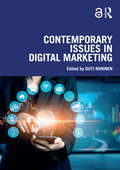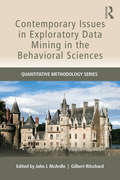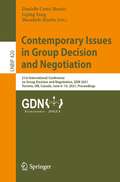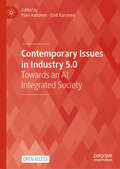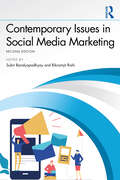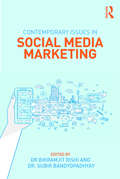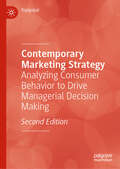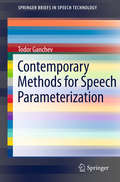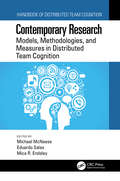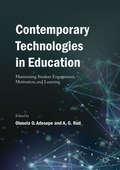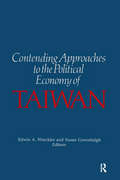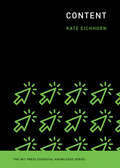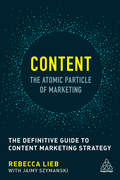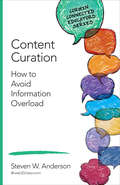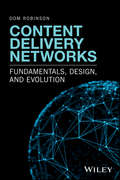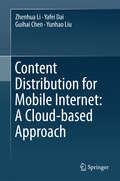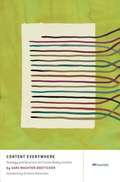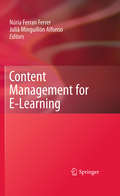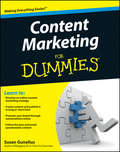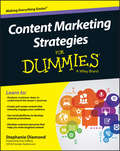- Table View
- List View
Contemporary Issues in Digital Marketing
by Outi NiininenThis book presents a comprehensive overview of the key topics, best practices, future opportunities and challenges in the Digital Marketing discourse. With contributions from world-renowned experts, the book covers: • Big Data, Artificial Intelligence and Analytics in Digital Marketing • Emerging technologies and how they can enhance User Experience • How ‘digital’ is changing servicescapes • Issues surrounding ethics and privacy • Current and future issues surrounding Social Media • Key considerations for the future of Digital Marketing • Case studies and examples from real-life organisations Unique in its rigorous, research-driven and accessible approach to the subject of Digital Marketing, this text is valuable supplementary reading for advanced undergraduate and postgraduate students studying Digital and Social Media Marketing, Customer Experience Management, Digital Analytics and Digital Transformation.
Contemporary Issues in Exploratory Data Mining in the Behavioral Sciences: Contemporary Issues In Exploratory Data Mining In The Behavioral Sciences (Quantitative Methodology Series)
by Gilbert Ritschard John J. McArdleThis book reviews the latest techniques in exploratory data mining (EDM) for the analysis of data in the social and behavioral sciences to help researchers assess the predictive value of different combinations of variables in large data sets. Methodological findings and conceptual models that explain reliable EDM techniques for predicting and understanding various risk mechanisms are integrated throughout. Numerous examples illustrate the use of these techniques in practice. Contributors provide insight through hands-on experiences with their own use of EDM techniques in various settings. Readers are also introduced to the most popular EDM software programs. A related website at http://mephisto.unige.ch/pub/edm-book-supplement/offers color versions of the book’s figures, a supplemental paper to chapter 3, and R commands for some chapters. The results of EDM analyses can be perilous – they are often taken as predictions with little regard for cross-validating the results. This carelessness can be catastrophic in terms of money lost or patients misdiagnosed. This book addresses these concerns and advocates for the development of checks and balances for EDM analyses. Both the promises and the perils of EDM are addressed. Editors McArdle and Ritschard taught the "Exploratory Data Mining" Advanced Training Institute of the American Psychological Association (APA). All contributors are top researchers from the US and Europe. Organized into two parts--methodology and applications, the techniques covered include decision, regression, and SEM tree models, growth mixture modeling, and time based categorical sequential analysis. Some of the applications of EDM (and the corresponding data) explored include: selection to college based on risky prior academic profiles the decline of cognitive abilities in older persons global perceptions of stress in adulthood predicting mortality from demographics and cognitive abilities risk factors during pregnancy and the impact on neonatal development Intended as a reference for researchers, methodologists, and advanced students in the social and behavioral sciences including psychology, sociology, business, econometrics, and medicine, interested in learning to apply the latest exploratory data mining techniques. Prerequisites include a basic class in statistics.
Contemporary Issues in Group Decision and Negotiation: 21st International Conference on Group Decision and Negotiation, GDN 2021, Toronto, ON, Canada, June 6–10, 2021, Proceedings (Lecture Notes in Business Information Processing #420)
by Liping Fang Danielle Costa Morais Masahide HoritaThis book constitutes the refereed proceedings of the 21st International Conference on Group Decision and Negotiation, GDN 2021, which was planned to be held in Toronto, ON, Canada, during June 6–10, 2021. The conference was held virtually due to the COVID-19 pandemic.The field of Group Decision and Negotiation focuses on decision processes with at least two participants and a common goal but conflicting individual goals. Research areas of Group Decision and Negotiation include electronic negotiations, experiments, the role of emotions in group decision and negotiations, preference elicitation and decision support for group decisions and negotiations, and conflict resolution principles. The 12 full papers presented in this volume were carefully reviewed and selected from 74 submissions. They were organized in topical sections as follows: pandemic responses; preference modeling for group decision and negotiation; conflict resolution; and collaborative decision making processes.
Contemporary Issues in Industry 5.0: Towards an AI Integrated Society (Technology, Work and Globalization)
by Päivi Aaltonen Emil Kurvinen‘Industry 5.0’ was first described in 2020 by the European Commission to describe the next wave of technologies, including Virtual Simulation and Automated Robots, to impact businesses and individuals. It recognizes how these technologies can no more be counted as purely ‘future tech’, but as realities that will begin to impact society as a whole. This open access book describes this new world as ’Society 5.0’ and explores the real impact of AI-enabled business on society. Beginning with a brief history of AI, the current terms, and its conceptual components, visualisation, data, and algorithms, this book then presents a collection of studies from leading scholars in the field of AI and Digital Business. The first section focuses on the immediate challenges and strategic changes that will be required for businesses to successfully adapt to this new reality. The second focuses on the opportunities of AI to businesses and society. And the final section includes chapters on the future and the possibilities and challenges that lie beyond Industry 5.0. It will be of great interest to scholars and students of innovation strategy and digital business, as well as all those engaged in research around cutting-edge technologies and their impact on society.
Contemporary Issues in Social Media Marketing
by Bikramjit Rishi Subir BandyopadhyayContemporary Issues in Social Media Marketing provides the most cutting-edge findings in social media marketing, through original chapters from a range of the world’s leading specialists in the area. This second edition has been fully updated with new features such as discussion questions, global case studies and examples, and material reflecting the key trends in the field, including: The growth in user-generated content. The growing influence of AI in content creation, including virtual influencers. The development and utilization of social media analytics. The use of social media as the primary search engine. The relationship between social media and the customer experience of the brand. Highly regarded for its breadth of topics, range of perspectives and research-based approach, this text is perfect recommended reading for advanced undergraduate and postgraduate students studying Digital and Social Media Marketing, Contemporary Issues in Marketing and Strategic Marketing. It will also be valuable reading for academics in the field and reflective practitioners.
Contemporary Issues in Social Media Marketing: An International Perspective
by Bikramjit Rishi Subir BandyopadhyayIn a short time span, social media has transformed communication, as well as the way consumers buy, live and utilize products and services. Understanding the perspectives of both consumers and marketers can help organizations to design, develop and implement better social media marketing strategies. However, academic research on social media marketing has not kept pace with the practical applications and this has led to a critical void in social media literature. This new text expertly bridges that void. Contemporary Issues in Social Media provides the most cutting edge findings in social media marketing, through original chapters from a range of the world’s leading specialists in the area. Topics include: • The consumer journey in a social media world • Social media and customer relationship management (CRM) • Social media marketing goals and objectives • Social media and recruitment • Microblogging strategy And many more. The book is ideal for students of social media marketing, social media marketing professionals, researchers and academicians who are interested in knowing more about social media marketing. The book will also become a reference resource for those organizations which want to use social media marketing for their brands.
Contemporary Marketing Strategy: Analyzing Consumer Behavior to Drive Managerial Decision Making
by RajagopalThis book offers knowledge and skills about developing market-centric and competition-oriented models and illustrates the power of consumers in managing sensitive market interventions through marketing-mix strategies, innovation, and technology applications for competitive markets. This updated edition discusses applied marketing concepts in real-life situations, incorporating new insights on the role of technology in marketing, with a particular emphasis on AI and machine learning, while also addressing topics related to consumer privacy and data protection. It will serve as a valuable resource for researchers interested in marketing in the digital age.
Contemporary Methods for Speech Parameterization (SpringerBriefs in Speech Technology)
by Todor GanchevContemporary Methods for Speech Parameterization offers a general view of short-time cepstrum-based speech parameterization and provides a common ground for further in-depth studies on the subject. Specifically, it offers a comprehensive description, comparative analysis, and empirical performance evaluation of eleven contemporary speech parameterization methods, which compute short-time cepstrum-based speech features. Among these are five discrete wavelet packet transform (DWPT)-based, six discrete Fourier transform (DFT)-based speech features and some of their variants which have been used on the speech recognition, speaker recognition, and other related speech processing tasks. The main similarities and differences in their computation are discussed and empirical results from performance evaluation in common experimental conditions are presented. The recognition accuracy obtained on the monophone recognition, continuous speech recognition and speaker recognition tasks is contrasted against the one obtained for the well-known and widely used Mel Frequency Cepstral Coefficients (MFCC). It is shown that many of these methods lead to speech features that do offer competitive performance on a certain speech processing setup when compared to the venerable MFCC. The last does not target the promotion of certain speech features but instead aims to enhance the common understanding about the advantages and disadvantages of the various speech parameterization techniques available today and to provide the basis for selection of an appropriate speech parameterization in each particular case.
Contemporary Performance and Political Economy: Oikonomia as a New Ethico-Political Paradigm (Routledge Advances in Theatre & Performance Studies)
by Katerina ParamanaContemporary Performance and Political Economy examines haunting concepts, relations, and artworks that demand our attention. Under capitalism, political and ethical considerations are subordinated to economic ones, and this subordination creates ghost worlds. Performance works, however, can offer insights into alternative politico-economic models. In this major contribution to the fields of contemporary performance and political economy, Katerina Paramana proposes that the investigation of performance works as economies can make the insights performance works offer visible. She positions the examination in relation to contemporary critiques of capitalism, neo-feudalism, and their by-products, and proposes and develops the notion of "oikonomia" as a means to theorize artworks which, through their house (oikos) rules (nomoi), propose ethico-political challenges to the economies in which they are embedded. For this, Paramana looks at politically positioned performance works created and presented in Cuba, Europe, Mexico, the UK, and the US. Her interest is in the politics, ethics, and effects of these works’ "house rules", and the insights they offer to the reconceptualization of political economy. Ultimately, this book aims to transform our understanding of economy’s purpose. It contributes to the development of a new ethico-political paradigm upon which a reconceptualization of political economy can be based. This inspiring study seeks to keep the fire for change alive by demonstrating that political economies, much like performances, are experiments that can be changed.This work will be of great interest to students and scholars in performance studies, theatre, visual cultures, politics, cultural studies, dance, and visual arts, and critical theorists.
Contemporary Research and Perspectives on Early Childhood Mathematics Education (ICME-13 Monographs)
by Christiane Benz Ann Anderson Anna Baccaglini-Frank Iliada Elia Joanne MulliganThis book brings together a collection of research-based papers on current issues in early childhood mathematics education that were presented in the Topic Study Group 1 (TSG 1) at the 13th International Congress on Mathematical Education (ICME-13), held at the University of Hamburg in 2016. It will help readers understand a range of key issues that early childhood mathematics educators encounter today. Research on early childhood mathematics education has grown in recent years, due in part to the well-documented, positive relation between children’s early mathematical knowledge and their later mathematics learning, and to the considerable emphasis many countries are now placing on preschool education. The book addresses a number of central questions, including: What is mathematical structural development and how can we promote it in early childhood? How can multimodality and embodiment contribute to early mathematics learning and to acquiring a better understanding of young children’s mathematical development? How can children’s informal mathematics-related experiences affect instruction and children’s learning in different mathematics content areas? What is the role of tools, including technology and picture books, in supporting early mathematics learning? What are the challenges in early childhood mathematics education for teachers’ education and professional development?
Contemporary Research: Models, Methodologies, and Measures in Distributed Team Cognition
by Michael D. McNeese; Eduardo Salas; Mica R. EndsleyThe objective of Contemporary Research: Models, Methodologies, and Measures in Distributed Team Cognition is to advance knowledge in terms of real-world interactions among information, people, and technologies through explorations and discovery embedded within the research topics covered. Each chapter provides insight, comprehension, and differing yet cogent perspectives to topics relevant within distributed team cognition. Experts present their use of models and frameworks, different approaches to studying distributed team cognition, and new types of measures and indications of successful outcomes. The research topics presented span the continuum of interdisciplinary philosophies, ideas, and concepts that underline research investigation. Features Articulates distributed team cognition principles/constructs within studies, models, methods, and measures Utilizes experimental studies and models as cases to explore new analytical techniques and tools Provides team situation awareness measurement, mental model assessment, conceptual recurrence analysis, quantitative model evaluation, and unobtrusive measures Transforms analytical output from tools/models as a basis for design in collaborative technologies Generates an interdisciplinary approach using multiple methods of inquiry
Contemporary Technologies in Education: Maximizing Student Engagement, Motivation, and Learning
by A. G. Rud Olusola O. AdesopeThis edited volume provides a critical discussion of theoretical, methodological, and practical developments of contemporary forms of educational technologies. Specifically, the book discusses the use of contemporary technologies such as the Flipped Classroom (FC), Massive Open Online Course (MOOC), Social Media, Serious Educational Games (SEG), Wikis, innovative learning software tools, and learning analytic approach for making sense of big data. While some of these contemporary educational technologies have been touted as panaceas, researchers and developers have been faced with enormous challenges in enhancing the use of these technologies to arouse student attention and improve persistent motivation, engagement, and learning. Hence, the book examines how contemporary technologies can engender student motivation and result in improved engagement and learning. Each chapter also discusses the road ahead and where appropriate, uses the current trend to predict future affordances of technologies.
Contending Approaches to the Political Economy of Taiwan (Taiwan In The Modern World Ser.)
by Susan Greenhalgh Edwin A. WincklerThis work compares IT parks in China, India, Malaysia, Singapore, Taiwan, and Hawaii, in search of strategies that policy makers can employ to reduce the Global Digital Divide, advance distributional equity, and soften some of the negative effects of economic globalization.
Content (The MIT Press Essential Knowledge series)
by Kate EichhornA concise introduction to content and the content industry, from the early internet to the Instagram egg.From the time we roll out of bed to check overnight updates to our last posts, likes, and views of the previous day, we're consuming and producing content. But what does the term &“content&” even mean? When did it become ubiquitous? And at what cost? In this volume in the MIT Press Essential Knowledge series, Kate Eichhorn offers a concise introduction to content and the content industry, examining the far-reaching effects content has on culture, politics, and labor in a digital age. Eichhorn traces the evolution of our current understanding of content from the early internet to the current social mediaverse. The quintessential example of content, she says, is the Instagram egg—an image that imparted no information or knowledge and circulated simply for the sake of circulation. Eichhorn explores what differentiates user-generated content from content produced by compensated (although often undercompensated) workers; examines how fields from art and literature to journalism and politics have weathered the rise of the content industry; and investigates the increasing importance of artists&’ &“content capital&”—the ability of artists, writers, and performers to produce content not about their work but about their status as artists.
Content - The Atomic Particle of Marketing: The Definitive Guide to Content Marketing Strategy
by Rebecca LiebDISTINGUISHED FAVOURITE: NYC Big Book Awards 2017Content, in all its forms, is the single most critical element of any marketing campaign. Finding a successful equilibrium between content marketing and content strategy is difficult, but essential. Content - The Atomic Particle of Marketing goes beyond superficial descriptions of how to produce engaging social media content to offer the results of many years of deep quantitative research, and hours of interviews with senior marketers at some of the world's leading brands. Written by a recognized industry thought leader, Content - The Atomic Particle of Marketing explores how content functions in the broader framework of all marketing, as well as organizational concerns and IT decision making. It demonstrates the value content brings not only to "owned" media initiatives, such as a company website or blog, but also the essential role content plays in all other marketing initiatives, from social media to advertising to offline channels. It will enable readers to make the organizational, staffing, tools and process decisions necessary to get content up and running across divisions and organizational silos. Deeply researched and insightful, Content - The Atomic Particle of Marketing is, quite simply, the definitive research-based guide to content marketing.
Content Creation mit Künstlicher Intelligenz für Dummies (Für Dummies)
by Rafael BujotzekKreativ und effizient mit Künstlicher Intelligenz Schluss mit Kreativblockaden und zeitraubender Routine! Texte formulieren, Mails beantworten oder Bilder, Töne und Videos gestalten – nutzen Sie KI als leistungsstarkes Werkzeug. Rafael Bujotzek verrät, wie Sie durch geschicktes Prompting beeindruckende Ergebnisse erzielen, Reichweite gewinnen und Workflows automatisieren. Entdecken Sie, wie generative KI die Content Creation revolutioniert und für mehr Barrierefreiheit sorgt. Von Content Management mit nützlichen KI-Tools bis zu juristischen Stolperfallen: Dieses Praxisbuch macht Sie ohne Vorkenntnisse startklar für die Content-Produktion. Sie erfahren Wobei ChatGPT, Copilot, Midjourney und Co. Sie unterstützen können Was KI-Agenten leisten Wie Sie mit KI virale Social-Media-Posts und Podcasts starten Wem Barrierefreiheit nützt Welche rechtlichen Pflichten Sie beachten müssen
Content Curation: How to Avoid Information Overload (Corwin Connected Educators Series)
by Steven W. AndersonSavvy internet consumption starts right here! Teachers and students are constantly inundated with information, yet lack the organizational skill necessary to effectively utilize it. From Twitter hashtags to online communities, this handy guide will help you to find, store, and share the best information and resources found on the web today—and teach your students to do the same. Real-world tips, tools, in-depth examples and lesson plans help you systematically: Understand the curation process Find, collect, and share reliable web-based information Build students’ information literacy skills Help students research and organize problem-based learning projects Use cutting-edge curation tools like Evernote, Diigo, and Pocket The Corwin Connected Educators series is your key to unlocking the greatest resource available to all educators: other educators. Being a Connected Educator is more than a set of actions: it’s a belief in the potential of technology to fuel lifelong learning. "Speaking from his own experience and perspectives as a learner, teacher, and educational leader, Steven Anderson brings clarity to a process that can be difficult and overwhelming. Steven offers tried and tested strategies and tools for evaluating, organizing, and sharing the vast amount of online content educators and students have at their fingertips. If you′re drowning in digital content, this book is your life jacket. " —Jayme Linton, Assistant Professor of Education Lenoir-Rhyne University, Hickory, NC
Content Curation: How to Avoid Information Overload (Corwin Connected Educators Series)
by Steven W. AndersonSavvy internet consumption starts right here! Teachers and students are constantly inundated with information, yet lack the organizational skill necessary to effectively utilize it. From Twitter hashtags to online communities, this handy guide will help you to find, store, and share the best information and resources found on the web today—and teach your students to do the same. Real-world tips, tools, in-depth examples and lesson plans help you systematically: Understand the curation process Find, collect, and share reliable web-based information Build students’ information literacy skills Help students research and organize problem-based learning projects Use cutting-edge curation tools like Evernote, Diigo, and Pocket The Corwin Connected Educators series is your key to unlocking the greatest resource available to all educators: other educators. Being a Connected Educator is more than a set of actions: it’s a belief in the potential of technology to fuel lifelong learning. "Speaking from his own experience and perspectives as a learner, teacher, and educational leader, Steven Anderson brings clarity to a process that can be difficult and overwhelming. Steven offers tried and tested strategies and tools for evaluating, organizing, and sharing the vast amount of online content educators and students have at their fingertips. If you′re drowning in digital content, this book is your life jacket. " —Jayme Linton, Assistant Professor of Education Lenoir-Rhyne University, Hickory, NC
Content Delivery Networks: Fundamentals, Design, and Evolution
by Dom RobinsonThe definitive guide to developing robust content delivery networks This book examines the real-world engineering challenges of developing robust content delivery networks (CDNs) and provides the tools required to overcome those challenges and to ensure high-quality content delivery that fully satisfies operators’ and consumers' commercial objectives. It is informed by the author’s two decades of experience building and delivering large, mission-critical live video, webcasts, and radio streaming, online and over private IP networks. Following an overview of the field, the book cuts to the chase with in-depth discussions—laced with good-natured humor—of a wide range of design considerations for different network topologies. It begins with a description of the author's own requirement filtration processes. From there it moves on to initial sketches, through considerations of stakeholder roles and responsibilities, to the complex challenges of managing change in established teams. Agile versus waterfall considerations within large blue chip companies, security, commercial models, and value chain alignment are explored in detail. Featured throughout the book are numerous "what if" scenarios that help provide a clear picture of the wide spectrum of practical contexts for which readers may be tasked with building and implementing a CDN. In addition, the book: Discusses delivery of live, catch-up, scheduled on-demand, TVOD and SVOD Offers insights into the decisions that can to be made when architecting a content distribution system over IP-based networks Covers CDN topologies, including Edge-Caching, Streaming-Splitting, Pure-Play, Operator, Satellite, and Hybrid Examines computer hosting and orchestration for dedicated appliances and virtualization Includes real-world cases covering everything from IETF, regulatory considerations, and policy formation, to coding, hardware vendors, and network operators Considers the future of CDN technologies and the market forces driving its evolution Written by a back-room engineer for back-room engineers, Content Delivery Networks gets readers up to speed on the real-world challenges they can face as well as tried-and-true strategies for addressing those challenges in order to ensure the delivery of the high-quality content delivery networks that clients demand and users expect.
Content Distribution for Mobile Internet: A Cloud-based Approach
by Yunhao Liu Zhenhua Li Yafei Dai Guihai ChenThis book investigates the cloud-based techniques of content distribution mainly for mobile Internet. It starts with hot topics such as cellular traffic optimization and video content delivery. By integrating the cloud scheme, it further tackles issues of traffic-saving, energy-efficient, high-speed, and delay-tolerant content delivery with regard to mobile Internet. It covers both theoretical algorithms and their real-world system implementations. In particular, various well-known cloud platforms such as Baidu Traffic Guard, Tencent QQXuanfeng, Google Drive, Microsoft OneDrive, and Dropbox are elaborated respectively in the book. Lastly, it includes an educational and experimental cloud computing platform allowing public access, which benefits researchers, practitioners, and developers in the field of cloud computing/storage and mobile Internet. Throughout the book there are helpful and practical tips on setting up cloud systems that readers can easily follow.
Content Distribution for Mobile Internet: A Cloud-based Approach
by Yunhao Liu Zhenhua Li Yafei Dai Guihai ChenContent distribution, i.e., distributing digital content from one node to another node or multiple nodes, is the most fundamental function of the Internet. Since Amazon’s launch of EC2 in 2006 and Apple’s release of the iPhone in 2007, Internet content distribution has shown a strong trend toward polarization. On the one hand, considerable investments have been made in creating heavyweight, integrated data centers (“heavy-cloud”) all over the world, in order to achieve economies of scale and high flexibility/efficiency of content distribution. On the other hand, end-user devices (“light-end”) have become increasingly lightweight, mobile and heterogeneous, creating new demands concerning traffic usage, energy consumption, bandwidth, latency, reliability, and/or the security of content distribution. Based on comprehensive real-world measurements at scale, we observe that existing content distribution techniques often perform poorly under the abovementioned new circumstances. Motivated by the trend of “heavy-cloud vs. light-end,” this book is dedicated to uncovering the root causes of today’s mobile networking problems and designing innovative cloud-based solutions to practically address such problems. Our work has produced not only academic papers published in prestigious conference proceedings like SIGCOMM, NSDI, MobiCom and MobiSys, but also concrete effects on industrial systems such as Xiaomi Mobile, MIUI OS, Tencent App Store, Baidu PhoneGuard, and WiFi.com. A series of practical takeaways and easy-to-follow testimonials are provided to researchers and practitioners working in mobile networking and cloud computing. In addition, we have released as much code and data used in our research as possible to benefit the community.
Content Everywhere: Strategy and Structure for Future-ready Content
by Sara Wachter-BoettcherCare about content? Better copy isn't enough. As devices and channels multiply--and as users expect to relate, share, and shift information quickly--we need content that can go more places, more easily. Content Everywhere will help you stop creating fixed, single-purpose content and start making it more future-ready, flexible, reusable, manageable, and meaningful wherever it needs to go.
Content Management for E-Learning
by Julià Minguillón Alfonso Núria Ferran FerrerThe increasing growth in the use of e-learning environments, in which education is delivered and supported through information and communication technologies, has brought new challenges to academic institutions. From all the current definitions of e-learning, it can be seen that learning contents are one of the key issues for a successful e-learning experience. Therefore, there is a real need for academic staff, managers and librarians to re-think the whole process of delivering courses, information resources and information services. The book focuses on defining content management and its relationship with knowledge management, providing perspectives on how the semantic web could complement content management, how to deal with copyright restrictions, and how to describe information competencies and skills required and acquired by teachers and students in virtual environments. Offered is a design project for managing digital content for classical and distance education institutions, covering all the aspects related to the content lifecycle, integrating it into the learning process. Practical aspects such as standards for content e-learning management, a review of existing experiences of learning repositories, and a survey of available platforms for delivering courses and providing access to information resources is also covered. Lastly, the book addresses the three main factors which make it crucial in the current context: first, the web 2.0 paradigm, which breaks the content producer-consumer barrier; second, the open content movement for educational purposes, which changes the knowledge management transference model; and third, the new European Higher Education Area, where the concept of content needs to be rethought.
Content Marketing For Dummies
by Susan GuneliusGet the whole picture and learn to create a successful online content marketing program Successful online marketing is about more than creating a Facebook page or writing a corporate blog. Brands need to build lasting connections with the right customers online through an effective online content marketing strategy, and this book shows you how. It explores ways to create a content marketing strategy, identify the content that will keep your customers coming back, create that content, distribute it online, and measure the results, with hands-on, step-by-step guidance. Content marketing is an essential element of successful online marketing and brand-building; this book shows you how to begin creating and distributing content online to market your business Explains why content marketing is important and how to create an online content marketing strategy, which tools to use, and what to avoid Shows how to create content and get it published online in long or short form Offers plenty of tips, case studies, and worksheets to ensure success Online content marketing positions your business and your product for lasting customer interaction; Content Marketing For Dummies gives you the tools to create a program that works.
Content Marketing Strategies For Dummies
by Stephanie DiamondDrive your content marketing campaign toward success Blogs and social platforms are all the rage right now-especially for strategists looking to cultivate influence among target audience members through content marketing. Content Marketing Strategies For Dummies explains how you can use content marketing to gain an edge over your competition, even in the most crowded of marketplaces. This timely text introduces you to the Five C Cycle: Company Focus, Customer Experience, Content Creation, Channel Promotion, and Closed-Loop Analysis. The Five C Cycle drives the creation and documentation of a targeted content marketing strategy, and allows you to approach your content marketing campaign with confidence. By helping you determine your company's focus, uncover your customers' experience with data, develop channel promotions across social platforms, create actionable online content, and use closed-loop analysis to build on previous success, this will become your go-to content marketing guide. Content marketing entails creating and curating content online via blog posts, social media platforms, and more. The goal is to acquire and retain customers by creating content that brings value to their lives, and that encourages them to engage with your brand. This easy-to-understand guide will help you do just that. Analyze customer data to better understand your target audience's journey Leverage social platforms, such as Facebook and Twitter, to develop channel promotions Create and curate intelligent, engaging content that leads to action Build upon your previous success with closed-loop analysis Whether you work for a large corporation, are part of a small business, are a solo thought leader, or are an educator, Content Marketing Strategies For Dummies tells you how to gain a critical, competitive advantage through targeted content marketing strategies.
